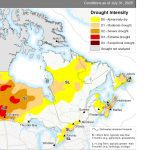Neighbours affect neighbours | Producers must work together and take action against herbicide resistance in their areas
BALTIMORE, Md. — Farmers are often categorized as rugged individuals who prefer to do things on their own and in their own way.
However, that “go it alone” attitude won’t work when it comes to herbicide resistant weeds, said David Ervin, an environmental sciences professor at Portland State University.
“I’m just convinced that individual efforts, alone, will not suffice,” Ervin told the Weed Science Society of America annual meeting held in Baltimore in early February.
“If they (farmers) continue to go it on their own … they’ll simply find that they are worse off in the long run.”
Read Also

Alberta eases water access for riparian restoration
Alberta government removes requirement for temporary diversion licence to water plants up to 100 cubic metres per day for smaller riparian restoration projects
The association released 12 best management practices last year to help growers cope with herbicide resistance, which has become a significant agronomic and economic issue in the southern United States and the U.S. Midwest as more weeds develop resistance to multiple modes of action.
However, Ervin said the list was incomplete.
“(It’s) like the missing best management practice. If (we) don’t have some kind of a collective effort … we’re simply not going to make the kind of progress that people want, in terms of corralling this issue.”
Ervin, who participated in a panel discussion about the sociological and economic aspects of herbicide resistance, said his own father bristled at the thought of working with others.
“I was raised on a farm and my father was as individualistic as you could imagine. He wouldn’t want to join anything.”
However, Ervin’s dad understood that his crops suffered if the neigh-bours didn’t control the weeds on their land.
As an example of the value of collective action, Ervin referred to a case in California where growers were squabbling over a common supply of groundwater.
The farmers eventually realized that the success of their farms de-pended on the actions of other growers and vice versa.
History and current experiences show that producers do co-operate for the common good, said Ray Jussaume, a sociology professor from Michigan State University.
He said the agricultural pioneers who settled western North America succeeded partly because they were determined, resourceful people, but help from their fellow pioneers also played a crucial role in their success.
Neighbours coming together to harvest a farmer’s crop when he falls ill during the growing season is a modern day example of co-operation, he added.
“They (growers) are already doing it in other areas. The idea now is to show them that managing weed resistance is as much of a common resource issue as helping your neighbour harvest their crop.”
However, the difficulty is persuading farmers to act collectively on herbicide resistance
Ervin said control is a key to successful collective action.
A small and local group of producers should control the collective effort to slow herbicide resistance in their region, rather than a global, top down approach.
“You may want to create little nests of associations within a larger umbrella,” he said.
“What you’re doing in building this kind of collective group is establishing trust…. They have to trust one another to be responsible and be-have according to the rules.”
Jussaume said weed scientists and policy-makers need to bring other experts onboard, such as sociologists, to understand farmer’s attitudes and perceptions regarding herbicide resistance.
For instance, the issue of personal responsibility will need to be part of the sales pitch to get growers on board if they blame the biotech industry for the problem by failing to warn them about the risks of herbicide resistance.
However, Jussaume said it’s obvious to him as a sociologist that technology didn’t cause the problem. The critical issue is managing existing biotech traits and the technologies in development.
“The way out of the conundrum is the approaches that people develop,” he said.
“It’s going to have to take (people) … to come up with approaches that recognize the complexity of the issue. Its not just, ‘here’s the technology and use it.’ ”

















